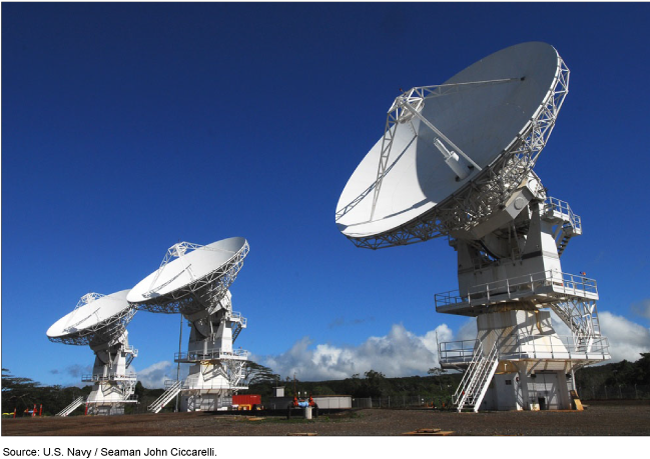Satellite Communications: DOD Should Explore Options to Meet User Needs for Narrowband Capabilities
Fast Facts
The U.S. military depends on systems of ultra high frequency ("narrowband") satellites for secure communications. The newest system provides cell-phone-like voice and data service to military users and could provide a 10-fold increase in communications capacity.
However, DOD isn't fully using the system—due in part to the military services' delays in delivering compatible radio equipment to users. As a result, users must continue to rely on an older satellite communications system, which is oversubscribed.
We made 2 recommendations to DOD, including that DOD find a solution to meet near-term user needs for satellite communications.

Highlights
What GAO Found
The Department of Defense (DOD) is not using the full capabilities of its latest ultra high frequency (narrowband) military satellite communications system, the Mobile User Objective System (MUOS). MUOS provides secure communications less vulnerable to weather conditions or other potential impediments. The full constellation of MUOS satellites has been on orbit for over 4 years, but DOD has not been able to use the system's advanced capabilities—such as its 10-fold increase in communications capacity. A key reason is the military services' delayed delivery of compatible radio terminals to users (see figure). DOD is funding and developing plans to accelerate procurement and delivery of these terminals.
Army Soldiers Using a Mobile User Objective System-Compatible Portable Terminal

DOD faces other challenges to its narrowband communications capabilities.
- In the near term, users continue to rely on the communications system that preceded MUOS, which is oversubscribed and will remain so while DOD works to field terminals and transition to MUOS. DOD has not explored and adopted narrowband communication options, which, if implemented, could help to meet unmet near-term communication needs.
- In the longer term, the five MUOS satellites that are on orbit have limited design lives. DOD plans to buy and launch additional satellites to sustain the constellation's availability, but without the legacy capability of the older system.
DOD has not determined its future narrowband satellite communication needs after MUOS. DOD has not updated its narrowband requirements since 2010 and has no plans to do so, although the uses, technology, and threats to communications have changed. Reexamining its narrowband communications needs will enhance DOD's ability to field a timely replacement for MUOS and ensure warfighters have needed communications tools in the future.
Why GAO Did This Study
DOD has invested $7.4 billion to develop, build, and begin delivering MUOS. However, longstanding gaps between the fielding of the satellite system and compatible user terminals have limited DOD's ability to fully use the system.
The Senate Armed Services Committee report to the bill for the National Defense Authorization Act for Fiscal Year 2020 contained a provision for GAO to review DOD's use of MUOS capabilities and any plans for a MUOS follow-on capability. In this report, GAO (1) provides information on the extent to which DOD is using MUOS advanced communications capabilities; (2) assesses DOD's challenges and steps taken in transitioning to these capabilities, and (3) assesses efforts DOD has underway to meet future narrowband satellite communications needs. This is a public version of a sensitive report that GAO issued in June 2021. Information that DOD deemed to be sensitive has been omitted.
GAO reviewed DOD planning documents, system assessments, and test reports. GAO also analyzed the services' terminal fielding and network transition plans. GAO interviewed oversight and acquisition officials across DOD.
Recommendations
GAO recommends DOD (1) explore and implement an option for narrowband satellite communications capabilities to meet near-term needs, and (2) reexamine its future narrowband satellite needs. DOD concurred with our recommendations and provided comments, which we incorporated as appropriate.
Recommendations for Executive Action
| Agency Affected | Recommendation | Status |
|---|---|---|
| Department of Defense | The Secretary of Defense should ensure the Office of the Under Secretary of Defense for Acquisition and Sustainment explores and implements an additional option for providing narrowband satellite communication capabilities in the near-term. (Recommendation 1) |
DOD indicated that while it concurred with this recommendation, it believes the best approach is accelerating plans to field MUOS terminals and transitioning legacy networks. DOD indicated it plans to continue to transition 70 percent of users from legacy systems to MUOS terminals to support network migration from legacy systems to the existing MUOS system by the end of 2026. We received a closure recommendation memo from the Deputy Assistant Secretary of Defense Strategic, Space, and Intelligence Portfolio Management asserting that they have funding in place to meet their 70% terminal placement goal and that terminal provisioning is on schedule. In addition, DOD completed a successful demonstration of the Integrated Broadcast Service's (IBS) use of MUOS Ultra High Frequency Legacy Extension (ULX) in April and May 2024. In February 2025, the final report on the ULX demonstration described progress achieved, and recommended additional testing to further optimize this capability for operations. Funding to continue integration and fielding of IBS over MUOS ULX was included in the President's Fiscal Year 2026 budget request. We consider these actions to meet the spirit of the recommendation.
|
| Department of Defense | The Secretary of Defense should ensure appropriate offices and components (such as the Joint Chiefs of Staff and U.S. Space Command) update DOD's future narrowband satellite communication requirements for the Space Force to prepare for an analysis of alternatives to begin as early as fiscal year 2022. (Recommendation 2) |
DOD agreed with this recommendation and completed the update to the Joint Satellite Communications Layer (JSCL) Initial Capabilities Document (ICD). This document was endorsed by the Joint Requirements Oversight Council in October 2023.
|
